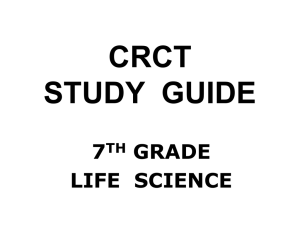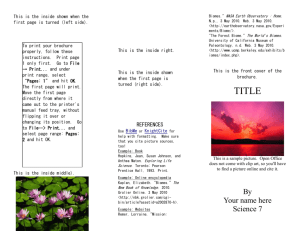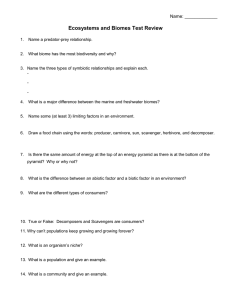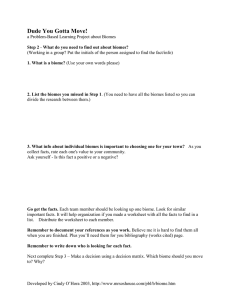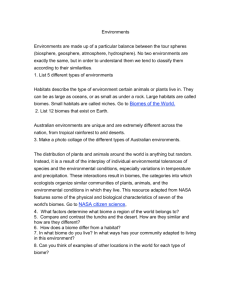Science Curriculum Fifth Grade
advertisement
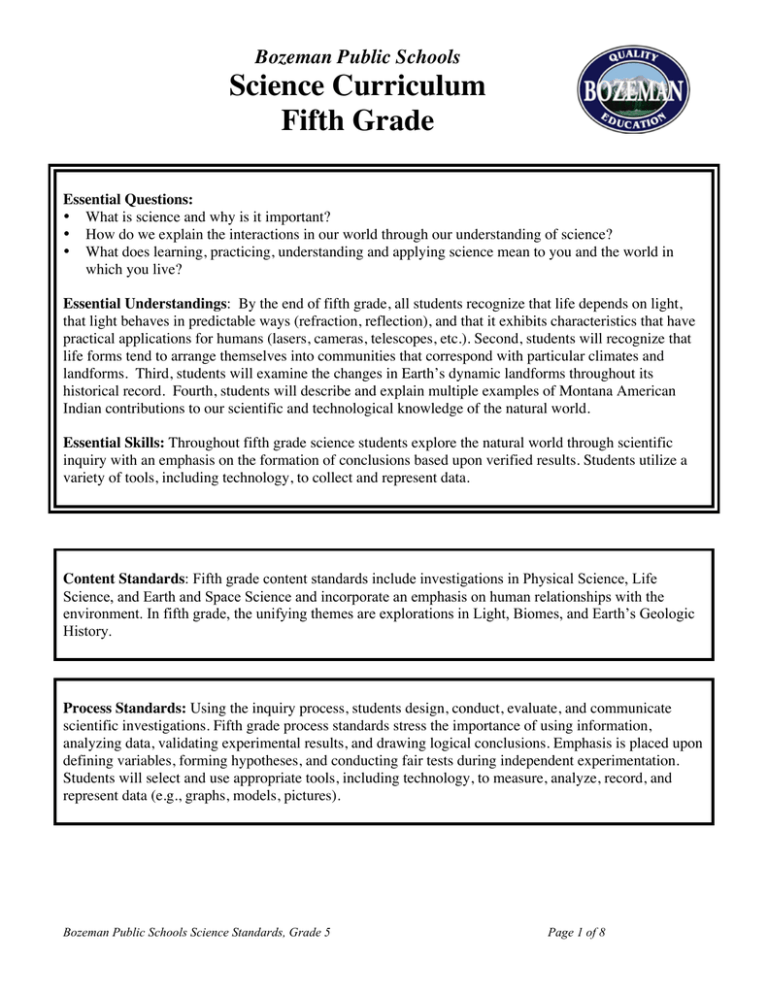
Bozeman Public Schools Science Curriculum Fifth Grade Essential Questions: • What is science and why is it important? • How do we explain the interactions in our world through our understanding of science? • What does learning, practicing, understanding and applying science mean to you and the world in which you live? Essential Understandings: By the end of fifth grade, all students recognize that life depends on light, that light behaves in predictable ways (refraction, reflection), and that it exhibits characteristics that have practical applications for humans (lasers, cameras, telescopes, etc.). Second, students will recognize that life forms tend to arrange themselves into communities that correspond with particular climates and landforms. Third, students will examine the changes in Earth’s dynamic landforms throughout its historical record. Fourth, students will describe and explain multiple examples of Montana American Indian contributions to our scientific and technological knowledge of the natural world. Essential Skills: Throughout fifth grade science students explore the natural world through scientific inquiry with an emphasis on the formation of conclusions based upon verified results. Students utilize a variety of tools, including technology, to collect and represent data. Content Standards: Fifth grade content standards include investigations in Physical Science, Life Science, and Earth and Space Science and incorporate an emphasis on human relationships with the environment. In fifth grade, the unifying themes are explorations in Light, Biomes, and Earth’s Geologic History. Process Standards: Using the inquiry process, students design, conduct, evaluate, and communicate scientific investigations. Fifth grade process standards stress the importance of using information, analyzing data, validating experimental results, and drawing logical conclusions. Emphasis is placed upon defining variables, forming hypotheses, and conducting fair tests during independent experimentation. Students will select and use appropriate tools, including technology, to measure, analyze, record, and represent data (e.g., graphs, models, pictures). Bozeman Public Schools Science Standards, Grade 5 Page 1 of 8 (P) Physical Sciences: Students demonstrate knowledge of types of force, forms of energy, mechanical systems, as well as physical properties of matter and changes in states of matter. Essential Questions: • How does our understanding of physical science help us explain the connections among matter, time, space & energy? • What are energy and matter and what is their relationship? • What gives matter its unique qualities? • How do the properties of matter affect its behavior? • What makes “it” “it” and why/how is it doing that? • How do things work? (M) Essential Learning Expectation - Matter: Matter exists in a variety of forms and can be classified by physical properties. Life depends on light. Light behaves in predictable ways (refraction, reflection, absorption), and it exhibits characteristics that have practical applications for humans (lasers, cameras, telescopes, etc.). PM.1.0 Structure: Students recognize that visible light is a portion of the electromagnetic spectrum, can be described by wavelength and frequency, and that colors are determined by their wavelengths. (Light, consisting of visible light, infrared and ultraviolet radiation, is a small part of a range of energy known as the electromagnetic spectrum.) PM.1.1 Students observe light in a variety of ways and then develop theories about the physical properties of light. PM.1.2 Students explore the questions of what light is and where it comes from. PM.1.3 Through research, students discover that light is formally described in terms of frequency and wavelength. PM.1.4 Students explore the concept that different wavelengths of light determine different colors. PM.2.0 Properties: Students recognize that light is unique in the universe, that it travels in straight lines as waves, that it does not require matter to travel great distances at great speed, and that in order to see an object light from that object must enter the eye. PM.2.1 Students describe how light travels in straight lines as waves. PM.2.2 Students observe the stars, planets, and the moon and explore the question of why we can see objects that are so far away. Example: light travels through vacuum of space PM.2.3 Students design an experiment to test the hypothesis that in order to see an object, light from that object must enter the eye. PM.3.0 Changes: Students demonstrate that light can be manipulated in predictable ways, including reflection (transmission), refraction (scattering), and absorption. Bozeman Public Schools Science Standards, Grade 5 Page 2 of 8 PM.3.1 Students experiment with various prisms, mirrors and lenses, record their observations, and develop theories about how light behaves. PM.3.2 Students demonstrate that light can be absorbed, reflected, and refracted in predicable ways. PM.3.3 Students develop and test theories for why objects that do not emit light are still visible. Example: class discussion including presentation of theories and “peer review” (F) Essential Learning Expectation – Force, Motion and Energy: Forces act upon objects and impact their motion. Motion can be described in terms of position, direction, and speed. Energy is a property of many substances and is associated with heat, light, electricity, mechanical motion and sound. Energy is transferred in many ways. PF.1.0 Types of Force: This learning goal is not addressed. PF.2.0 Forms of Energy: Students define light as a form of energy and the Sun as a major source of light energy. PF.2.1 Students review the concept that light is a form of energy and identify the Sun as a major source of light energy. PF.3.0 Mechanical Systems: Students examine optical devices and identify their important components. PF.3.1 Students deconstruct optical devices, label and diagram their components, and explain how the devices work. Example: camera, telescope, binoculars, microscopes, periscopes, kaleidoscopes. PF.3.2 Students design and construct pinhole cameras and describe how they work. (L) Life Science: As a result of the curriculum activities all students begin to develop an understanding of the characteristics of organisms, life cycle and environments of organisms. Essential Questions: • What is life? • How do systems, structures (form and function) and behavior patterns of organisms enable them to survive and interact with their environment? • How did life begin, how has it changed and how might it change in the future? • How is life interdependent on the Earth's conditions or other life? Bozeman Public Schools Science Standards, Grade 5 Page 3 of 8 (S) Essential Learning Expectation – Living Systems: Living systems encompass a diversity of organisms that are classified according to characteristics (structure, function and organization). Living systems involve interactions among organisms and their environment (biotic and abiotic). Organisms evolve through genetic change leading to adaptation. Life forms tend to arrange themselves into communities that correspond with particular climates and landforms that provide for the needs of individual organisms. LS1.0 Characteristics of Living Things: Students compare and contrast visible physical characteristics of organisms (plants and animals) within and among particular biomes. LS.1.1 Students will sort signature species of plants and animals into their respective biomes. Example: Camels and cacti in deserts, alligators and mangroves in swamps, etc LS.1.2 Students will explore the question of how each organism’s physical characteristics allow it to survive in its environment. Example: Camel’s hump, jackrabbit’s ears and long feet, taproot in dry areas, etc,. LS.2.0 Characteristics of Living Environments: Students describe, compare, and contrast living conditions within various biomes (i.e., the interrelationships among climates, landforms, and resources). LS.2.1 Students research and communicate living conditions within each of the major biomes. LS.2.2 Students compare and contrast living conditions within various biomes. Example: Students collectively study one national park that encompasses several of the major biomes. Next, each student does individual research about one biome found elsewhere in the world. Finally, pairs of students compare their research and present their findings to the class. L.S.2.3 Students explore the question, “Bozeman is located in which biome?” LS.3.0 Structure and Function: Students classify living things within a biome by their function as a producer, consumer or decomposer. Students construct food webs for the specific biome environments. LS.3.1 Students demonstrate their knowledge of the various roles organisms occupy in a biome. Example: graphic organizer, skit, diorama, song, poem… LS.3.2 Students construct a food web for specific biomes. Example: magazine pictures with arrows, yarn lines, stuffed animals… LS.4.0 Diversity and Adaptation: Students will compare and contrast the adaptations and strategies that have evolved among various organisms in order to cope with conditions within particular biomes. Students will begin to understand the extinction of species by examining fossil evidence. LS.4.1 Students explore structural adaptations that exist in organisms in various biomes. Example: camouflage, beaver’s flat tail and teeth, giraffe’s flat tongue, mangrove roots, cactus leaves, carnivorous plants, etc. Bozeman Public Schools Science Standards, Grade 5 Page 4 of 8 LS.4.2 Students will describe specific behavioral strategies that have allowed species to adapt and survive within and among biomes. Example: mammals within the tundra or alpine biome (hibernation, migration, estivate, caching/Columbian ground squirrels, elk, bears, pikas) mammals within the tundra or alpine biome (hibernation, migration, estivate, caching/Columbian ground squirrels, elk, bears, pikas) LS.4.3 Students investigate fossil evidence to understand adaptations of prehistoric animals and plants. Example: visit to MOR; utilize Internet for background research, web quest (P) Essential Learning Expectation - Life Process: Plants and animals have basic needs and life processes including growth, survival needs, cycles, and similarities among offspring and their parents. LP.1.0 Growth: Students account for the effects of climate and resources on rates of growth for plants and animals in different biomes. LP.1.1 Students explore the question of how climate affects the growth of plants and animals. Example: sunlight duration, water quantity, temperature that support/ influence growth LP.1.2 Students explore the question of how resources affect the growth of plants and animals. Example: sunlight intensity, water quality, soil composition that support/ influence growth LP2.0 Cycles: Students account for the effects of climate and resources (biotic and abiotic) on the life cycles of plants and animals in different biomes. LP.2.1 Students explore a variety of life cycles and the effects of climate and available resources on the growth and life span of organisms. Example: abundant resources allow rapid growth, inadequate resources limit growth, see NFS website LP.2.2 Students explore a variety of plant and animal relationships in the biomes on Earth and discuss the impact of these relationships on the organisms and .the environment Example: Predator/prey (hare/lynx), see FWP website, visit from FWP presenter LP.3.0 Reproduction: Students explore and discuss a variety of reproductive methods (viviporous, oviporous, ovoviporus, vegetative propagation, flowers, cones) and survival strategies (litter, one offspring, air borne/water borne seeds) that promote propagation of plant and animal species. LP.3.1 Students identify different reproductive methods and survival strategies that promote propagation of plant and animal species. Example: Methods: viviporous, oviporous, ovoviporus, flowers, cones vegetative propagation (inherited traits) Strategies: litters, single offspring, air borne/water borne seeds Bozeman Public Schools Science Standards, Grade 5 Page 5 of 8 (E) Earth and Space Science: As a result of the inquiry-based curricular activities all students develop an understanding of composition and structures of the Earth, objects in the sky and changes in Earth and sky. Essential Questions: • What is our world made of, how has it changed and how will it continue to change? • What evidence is used to help us interpret Earth's history? • How do we explain where we are in space and time? • Why does the Earth shake, rattle and roll? (S) Essential Learning Expectation – Earth and Space Structures: The Earth system is classified into four interacting components consisting of the geosphere, hydrosphere, atmosphere and biosphere. The Earth’s dynamic geosphere can change quickly through catastrophic events or slowly over geological time. Weathering, cooling, heating, and compression perpetuate the Rock Cycle. The Water cycle affects landforms both catastrophically and geologically. ES.1.0 Earth and Planetary Materials: Students recognize that the structure of the Earth’s geosphere consist of layers (core, mantel, crust) and can be identified by the role each has in the formation and change of Earth’s dynamic landforms. ES.1.1 Students identify the layers of the Earth’s geosphere. Example: core, mantel, crust ES.1.2 Students recognize that each layer of the Earth’s geosphere plays a role in the formation and changes of Earth’s dynamic landforms. ES.2.0 Landforms (geomorphology) Students know that a variety of destructive and constructive processes are involved in the continual shaping and forming of Earth’s landforms. ES.2.1 Students identify the destructive and constructive processes involved in the shaping and forming of landforms. Example: formation of landforms due to magma upwelling, erosion ES.3.0 Planetary Systems: This learning goal is not addressed. (I) Essential Learning – Earth and Space Interrelationships – Patterns, Cycles and ChangeThe dynamic nature of the lithosphere have profound effects on processes within Earth’s systems. Some Earth changes happen quickly and some happen slowly. EI.1.0 Weather, Climate and Change: Students discover and explain how heating, cooling, compression and weathering perpetuate the rock cycle and how evaporation and transpiration, precipitation, condensation, and collection perpetuate the water cycle. EI.1.1 Students explore, through inquiry processes, the effects of heating, cooling, compression and weathering on a variety of rocks. Example: compare and contrast effects on sedimentary, metamorphic, igneous. Bozeman Public Schools Science Standards, Grade 5 Page 6 of 8 EI.1.2 Students explore, through inquiry processes, the effects of transpiration, precipitation, condensation and collection on the water cycle. Example: finite fresh water supply, all water is recycled EI.2.0 Living Organisms: This learning goal is not addressed. EI.3.0 Earth’s History: Students study the theories of continental drift and plate tectonics to explain Earth’s structural changes throughout Earth’s history and connect Earth’s active, geologic landform features to lithospheric plate movement. EI.3.1 Students identify key structural changes and their causes throughout Earth’s history. Example: theory of Pangaea EI.3.2 Students understand that there is a connection between Earth’s active core, lithospheric plate movement and formation/destruction of landforms. EI.4.0 Catastrophic Events: Students identify the explosive processes of earthquakes and volcanic eruptions and their contributions to the constructive changes of Earth’s lithosphere and know that severe weather can contribute to the destructive changes of Earth’s lithosphere. EI.4.1 Students identify the explosive processes of earthquakes and volcanic eruptions and their contributions to the constructive changes of Earth’s lithosphere Example: mountain building EI.4.2 Students know identify types of severe weather that contribute to the destructive changes of Earth’s lithosphere. Example: hurricanes, tornadoes, floods EI.5.0 Planetary Systems: This learning goal is not addressed. (H) Place Based Issues (Human Relationships with the Environment): As a result of inquiry-based curriculum activities all students use scientific evidence to analyze local, regional and global scientific issues with an emphasis on the Gallatin Valley and the Greater Yellowstone Ecosystem. Essential Questions: • How did I get here, how do I explain what is going on here, how do I impact this place and how does this place impact me? • Which impact is more significant – humans on the earth or the earth on humans? • How do developments in science and technology affect our lives and where we live? • How can we be a part of nature, not apart from it? (T) Essential Learning Expectation – Technology: Our lives and community are shaped in many ways by the advances in science and technology. Science and technology are reciprocal; science drives technological advances, which in turn drives future scientific endeavors. HT.1.0 Technology: Students know that properties of light have affected human endeavors as well as the development of new technologies. Bozeman Public Schools Science Standards, Grade 5 Page 7 of 8 HT.1.1 Students identify how the properties of light have affected human endeavors and the development of new technologies. Example: lasers, light bulbs, cameras, (R) Essential Learning Expectation – Resources: Natural resources are unique to each region. Scientific evidence can be used to understand and manage natural resources. The search for, processing of, and use of resources has beneficial and/or detrimental impacts on both regional and global systems. HR.1.0 Resources: Students research and identify our local ecosystems and regional biome (Yellowstone Park, Gallatin valley, surrounding mountain ranges) and the unique animals, plants, landforms and climate found in the area. HR1.1 Students identify the local ecosystems and regional biome (Yellowstone Park, Gallatin valley, surrounding mountain ranges). Example: FWP website for our region HR1.2 Using inquiry processes, students identify the animals, plants, landforms and climate found in the Greater Yellowstone ecosystem. Example: FWP website for our region (I) Essential Learning Expectation – Culture: Many cultures make contributions to science and technology affecting societies in different ways. Science, technology and human activity are interrelated. HI.1.0 Culture: Students identify how the geological changes to the Greater Yellowstone Ecosystem have affected the historical development of human populations, beginning with ancient Native Americans and other indigenous people and continuing to present day. HI.1.1 Students construct a timeline of geological changes in the Greater Yellowstone Ecosystem. Example: dinosaurs, water resources, buffalo, wild game, mineral resources: gold, copper, silver, yogo sapphires HI.2.1 Students discuss the development of human populations, including Montana Native Americans and immigrant populations and their impact on the Greater Yellowstone Ecosystem. Example: Recreation fishing, hunting, skiing, hiking, vacation destination (parks) Bozeman Public Schools Science Standards, Grade 5 Page 8 of 8


